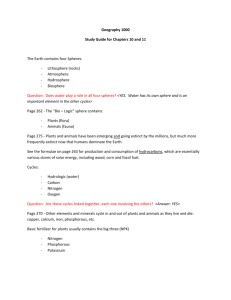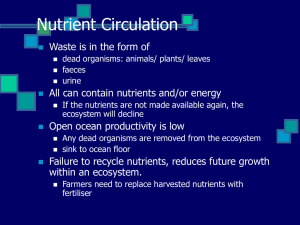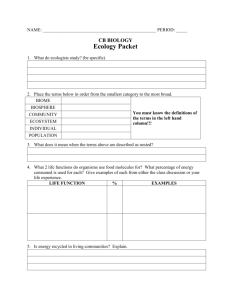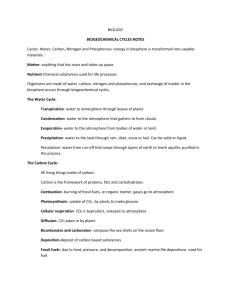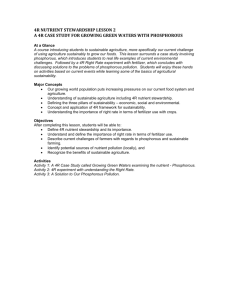Spark 101 Student Resource ISN_Nutrients in the Bay
advertisement
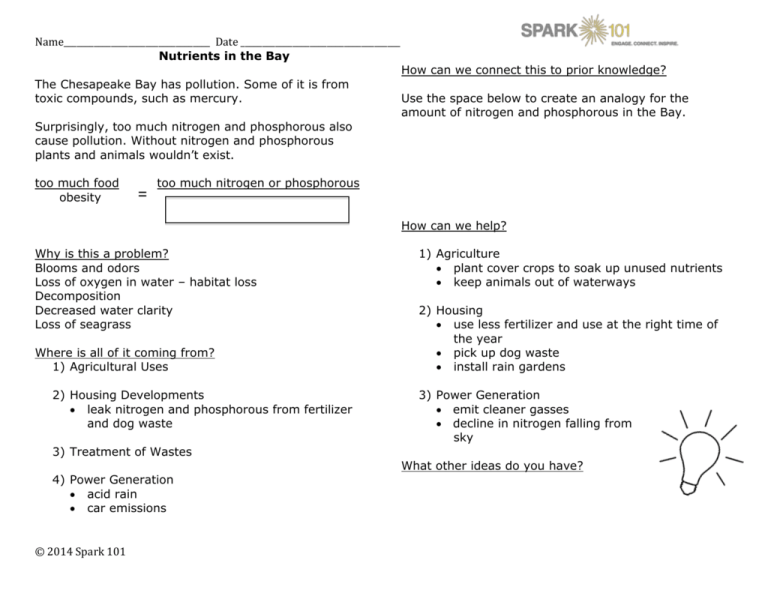
Name__________________________________ Date _____________________________________ Nutrients in the Bay The Chesapeake Bay has pollution. Some of it is from toxic compounds, such as mercury. How can we connect this to prior knowledge? Use the space below to create an analogy for the amount of nitrogen and phosphorous in the Bay. Surprisingly, too much nitrogen and phosphorous also cause pollution. Without nitrogen and phosphorous plants and animals wouldn’t exist. too much food obesity = too much nitrogen or phosphorous How can we help? Why is this a problem? Blooms and odors Loss of oxygen in water – habitat loss Decomposition Decreased water clarity Loss of seagrass Where is all of it coming from? 1) Agricultural Uses 2) Housing Developments leak nitrogen and phosphorous from fertilizer and dog waste 3) Treatment of Wastes 4) Power Generation acid rain car emissions © 2014 Spark 101 1) Agriculture plant cover crops to soak up unused nutrients keep animals out of waterways 2) Housing use less fertilizer and use at the right time of the year pick up dog waste install rain gardens 3) Power Generation emit cleaner gasses decline in nitrogen falling from sky What other ideas do you have? Name__________________________________ Date _____________________________________ Nutrients in the Bay Nutrients in the Bay The Chesapeake Bay has ______________. Some of it is from toxic compounds, such as mercury. The Chesapeake Bay has ______________. Some of it is from toxic compounds, such as mercury. Surprisingly, too much nitrogen and phosphorous also cause pollution. Without nitrogen and phosphorous plants and animals wouldn’t exist. Surprisingly, too much nitrogen and phosphorous also cause pollution. Without nitrogen and phosphorous plants and animals wouldn’t exist. too much food obesity too much food obesity Why = too much nitrogen or phosphorous is this a problem? Blooms and odors Loss of oxygen in water – _____________ loss Decomposition Decreased water ___________ Loss of seagrass Where is all of it coming from? 1) ____________________ Why = too much nitrogen or phosphorous is this a problem? Blooms and odors Loss of oxygen in water – _____________ loss Decomposition Decreased water ___________ Loss of seagrass Where is all of it coming from? _____________ 1) ____________________ _____________ 2) _________________ ____________________ leak nitrogen and phosphorous from fertilizer and dog waste 2) _________________ ____________________ leak nitrogen and phosphorous from fertilizer and dog waste 3) ________________ of Wastes 3) ________________ of Wastes 4) ________________ acid rain car emissions © 2014 Spark 101 ____________________ 4) ________________ acid rain car emissions ____________________ Name__________________________________ Date _____________________________________ How can we connect this to prior knowledge? How can we connect this to prior knowledge? Use the space below to create an analogy for the amount of nitrogen and phosphorous in the Bay. Use the space below to create an analogy for the amount of nitrogen and phosphorous in the Bay. How can we help? How can we help? 1) Agriculture plant cover crops to soak up unused nutrients keep animals out of waterways 4) Agriculture plant cover crops to soak up unused nutrients keep animals out of waterways 2) Housing use less fertilizer and use at the right time of the year pick up dog waste install rain gardens 5) Housing use less fertilizer and use at the right time of the year pick up dog waste install rain gardens 3) Power Generation emit cleaner gasses decline in nitrogen falling from sky 6) Power Generation emit cleaner gasses decline in nitrogen falling from sky What other ideas do you have? © 2014 Spark 101 What other ideas do you have?
